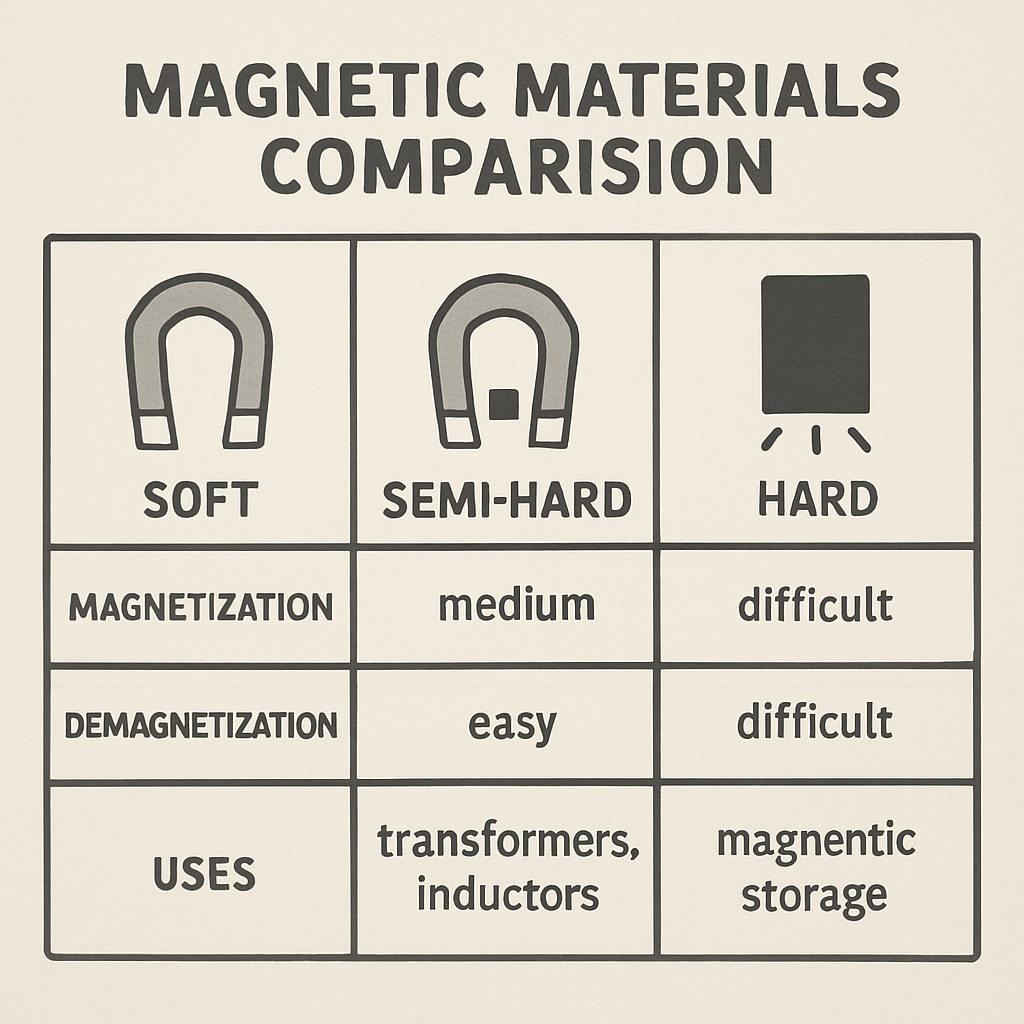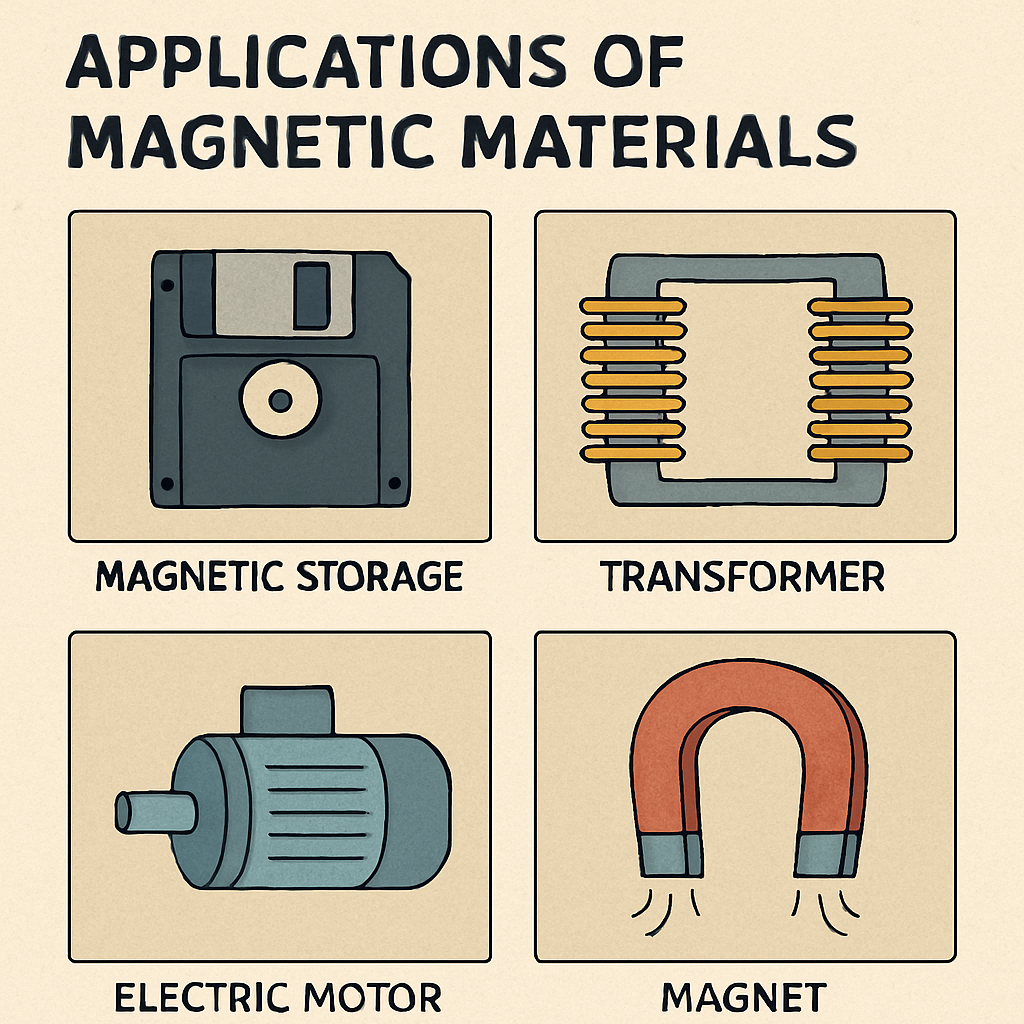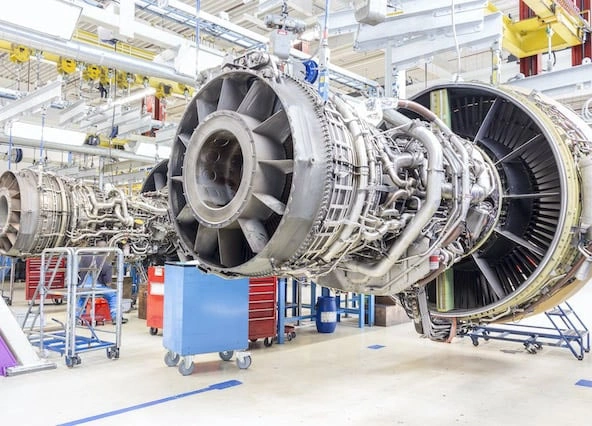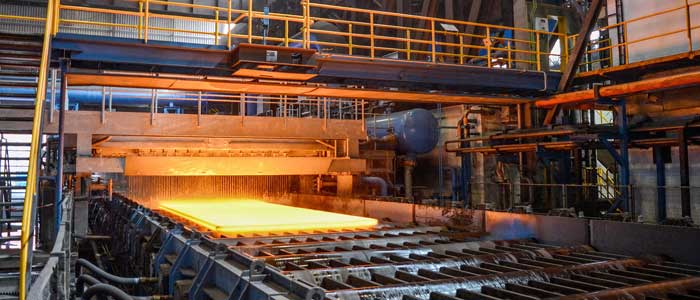In the world of physics, magnetic materials are integral to the functioning of many devices and technologies, ranging from everyday household appliances to complex industrial machinery. These materials are pivotal in converting electrical energy to mechanical energy, storing data, and even in medical devices such as MRI machines. Understanding the differences between hard and soft magnetic materials is essential for selecting the right type for your specific needs. This article will provide a comprehensive overview of hard and soft magnetic materials, including their definitions, properties, and applications, to aid in making informed decisions for various technological and industrial applications.
Magnetic materials are substances that can be magnetized or naturally possess inherent magnetic properties. These materials are characterized by their response to external magnetic fields and are categorized based on their magnetic susceptibility, which indicates the degree to which they can be magnetized. The main types of magnetic materials include ferromagnetic, paramagnetic, and diamagnetic materials, each exhibiting distinct magnetic behaviors that influence their applications in technology and industry.
Ferromagnetic materials are characterized by their high magnetic susceptibility and the ability to maintain their magnetization even after the external magnetic field is removed. This property makes them ideal for creating permanent magnets, essential in various applications such as electric motors and generators. Common examples of ferromagnetic materials include iron, cobalt, and nickel, which are often used in engineering and electronics due to their strong magnetic properties. These materials can exhibit phenomena such as magnetic hysteresis, which is crucial for understanding their behavior in alternating magnetic fields.
Paramagnetic materials exhibit a weak attraction to magnetic fields, and they do not retain their magnetization once the external field is removed, making them unsuitable for permanent magnet applications. These materials, such as aluminum and platinum, are often used in applications where temporary magnetization is sufficient. On the other hand, diamagnetic materials are characterized by their tendency to be repelled by magnetic fields, exhibiting no permanent magnetic properties. Materials like copper and bismuth fall into this category, and they are often used in applications requiring non-magnetic materials or in magnetic levitation technologies.
The distinction between hard and soft magnetic materials is primarily based on their ability to retain magnetization and their magnetic coercivity, which measures the resistance to becoming demagnetized. Understanding these differences is crucial for selecting the right material for specific applications, as they determine the material’s performance in maintaining or changing its magnetization state. This understanding is particularly important in designing magnetic circuits and devices that require precise magnetic field control.
Hard Magnetic Materials Definition
Hard magnetic materials, also known as permanent magnets, are characterized by their high coercivity, meaning they can maintain their magnetization even after the external magnetic field is removed. These materials are integral to applications where a consistent and stable magnetic field is required, such as in motors, generators, and magnetic storage devices. The ability to retain magnetization makes these materials ideal for use in environments where long-term magnetic stability is crucial, such as in aerospace and automotive industries.
Properties of Hard Magnetic Materials
- High Coercivity: This property allows hard magnetic materials to withstand strong demagnetizing forces, making them reliable in maintaining their magnetization over time.
- High Retentivity: They can retain a strong magnetic field, which is essential for applications requiring stable and consistent magnetic performance.
- Resistance to Demagnetization: Hard magnetic materials exhibit stable magnetism over time, even when exposed to external magnetic disturbances, making them suitable for harsh environments and critical applications.
Common Hard Magnetic Alloys
- Alnico: An alloy composed of aluminum, nickel, and cobalt, Alnico is known for its excellent temperature stability and is often used in high-temperature applications.
- Ferrite: This ceramic compound, composed of iron oxide mixed with metallic elements, is commonly used in magnetic cores for its cost-effectiveness and good magnetic properties.
- Samarium Cobalt: Offering high magnetic strength and thermal stability, this alloy is used in high-performance motors and devices that operate under extreme conditions.
Soft Magnetic Materials Definition
Soft magnetic materials, characterized by their low coercivity, are easily magnetized and demagnetized. They are used in applications where the magnetic field needs to change rapidly, such as in transformers, inductors, and electromagnets. These materials are crucial in applications that require efficient energy conversion and minimal energy loss, making them vital in power distribution and electronic devices.
Properties of Soft Magnetic Materials
- Low Coercivity: This property allows soft magnetic materials to be easily demagnetized and remagnetized, making them ideal for dynamic applications.
- High Permeability: Soft magnetic materials efficiently conduct magnetic fields, which is essential for minimizing energy loss in applications such as transformers and inductors.
- Low Retentivity: They do not retain significant magnetization when the external field is removed, which is advantageous in applications requiring frequent cycling of magnetic fields.
Common Soft Magnetic Alloys
- Silicon Steel: Known for its low hysteresis loss, silicon steel is widely used in transformer cores to improve energy efficiency and reduce energy loss.
- Permalloy: An alloy of nickel and iron, permalloy is recognized for its high magnetic permeability and is commonly used in magnetic shielding and sensor applications.
- Soft Ferrite: Utilized in high-frequency applications, soft ferrite is valued for its low electrical conductivity, which minimizes eddy current losses.
Applications of Hard and Soft Magnetic Materials
Understanding the diverse applications of hard and soft magnetic materials is essential for selecting the right material for specific requirements, ensuring optimal performance and efficiency.
Applications of Hard Magnetic Materials
- Electric Motors: Permanent magnets are used to generate a magnetic field necessary for motor operation, playing a crucial role in the functionality of various motor types.
- Magnetic Storage: Used in computer hard drives and magnetic recording devices, hard magnetic materials provide the stability required for reliable data storage.
- Sensors and Actuators: Employed in various sensors and actuators, hard magnetic materials provide the constant magnetic field necessary for precise operation and measurement.
Applications of Soft Magnetic Materials
- Transformers: Soft magnetic cores improve energy efficiency by reducing energy loss, making them essential in power distribution and electrical grids.
- Electromagnets: Used in devices where the magnetic field needs to be switched on and off, soft magnetic materials allow for rapid changes in magnetization.
- Inductors and Chokes: Employed in electronic circuits for filtering and energy storage, soft magnetic materials are crucial for ensuring efficient circuit performance.
Soft vs Hard Magnetic Materials: Key Differences
Understanding the key differences between soft and hard magnetic materials can aid in determining the appropriate use for each type, optimizing performance in various applications:
- Coercivity: Hard magnetic materials possess high coercivity, providing resistance to demagnetization, while soft magnetic materials have low coercivity, allowing for easy magnetization and demagnetization.
- Magnetization: Hard materials retain magnetization, making them suitable for permanent applications, whereas soft materials do not retain magnetization, making them ideal for applications requiring frequent changes in magnetic state.
- Applications: Hard magnetic materials are used for permanent magnets in applications requiring stable magnetic fields, while soft materials are used in applications requiring rapid changes in magnetization, such as transformers and inductors.
Conclusion
In summary, both hard and soft magnetic materials are essential in various applications, each offering unique properties and benefits. By understanding their definitions, properties, and applications, you can make informed decisions when selecting magnetic materials for your specific needs. Whether you require permanent magnetism for stable and long-term applications or materials that can be easily magnetized and demagnetized for dynamic applications, knowing the differences between hard and soft magnetic materials is crucial for optimizing performance and efficiency in your projects. Selecting the right type of magnetic material can significantly enhance the functionality, efficiency, and reliability of your devices and systems, contributing to advancements in technology and industry.









